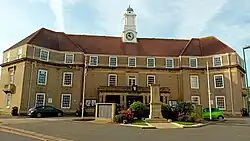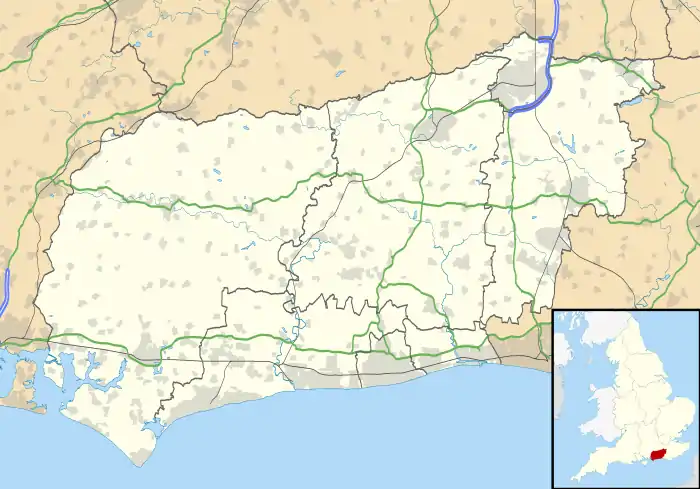| Bognor Regis Town Hall | |
|---|---|
 Bognor Regis Town Hall | |
| Location | Clarence Road, Bognor Regis |
| Coordinates | 50°47′00″N 0°40′13″W / 50.7833°N 0.6704°W |
| Built | 1930 |
| Architect | Charles Cowles-Voysey |
| Architectural style(s) | Neo-Georgian style |
Listed Building – Grade II | |
| Official name | Bognor Regis Town Hall |
| Designated | 24 January 2003 |
| Reference no. | 1350337 |
 Shown in West Sussex | |
Bognor Regis Town Hall is a municipal building in Clarence Road, Bognor Regis, West Sussex, England. The town hall, which is the meeting place of Bognor Regis Town Council, is a Grade II listed building.[1]
History
Bognor was governed by improvement commissioners from 1822. The commissioners established an office in the High Street.[2] In the late 1830s the town clerk relocated to the assembly rooms in Sudley Road and, in 1882, the Jubilee School in the High Street was converted for municipal use.[2] Improvement commissioners' districts were reconstituted as urban districts under the Local Government Act 1894, and so Bognor's commissioners were replaced by Bognor Urban District Council.[3] In 1929 the council decided to build a dedicated town hall: the site selected had formed part of the grounds of a convalescent home.[4] The site selection caused some controversy as Clarence Road was seen as a "back street" by some councillors.[2]
Foundation stones for the new building were laid by a long-serving member of the council, Councillor William Grice, and the chairman of the council, Canon Arthur Sacre, on 22 May 1929.[2] At the same time that construction began the council also petitioned George V to be allowed to add "Regis" to the town's name; the name was formally changed to Bognor Regis on 26 July 1929.[5]
The town hall was designed by Charles Cowles-Voysey in the Neo-Georgian style, built in yellow brick with stone dressings by a local contractor, H. W. Seymour, and officially opened by Mrs Eleanor Sacre on 11 October 1930.[1] The design involved a main frontage of nine bays facing onto the corner of Clarence Road and Belmont Street with the end bays canted forward; the central section of five bays featured a three-bay portico with paired square piers supporting an entablature and a wide stone balcony bearing a shield; there were a French windows on the first floor and a lantern above at roof level.[1] Internally, the principal room was the council chamber on the first floor.[6]
A war memorial, which had been designed by William Tillott Barlow and unveiled by Major-General Sir John Frederick Daniell, late of the Royal Marine Light Infantry, in Waterloo Square on 11 November 1921, was relocated to the area in front of the town hall in time for its opening,[7] and a Royal Warrant issued by King George V allowing the town to use the suffix "Regis" in honour of his residence in the town during his convalescence in late 1928 was installed in the council chamber.[8]
The building was used as a surface air raid shelter during the Second World War[2] and the assembly hall hosted a variety of performers in the post-war years, including the singer-songwriter, David Bowie, on 10 June 1967.[6] The town hall remained the headquarters of Bognor Regis Urban District Council for much of the 20th century but ceased to be the local seat of government after the enlarged Arun District Council was formed in 1974.[9] The district council continued to keep an area office in the town hall[10] and the town council, which was formed in 1984, established the town hall as its main meeting place.[11] A clock was added to the turret to mark the new millennium in the year 2000[2] and the building became recognised as an "asset of community value" in May 2018.[12]
References
- 1 2 3 Historic England. "Bognor Regis Town Hall (1350337)". National Heritage List for England. Retrieved 14 February 2021.
- 1 2 3 4 5 6 "Changing Times: Town hall is about to enter its 90th year of use". Bognor Regis Post. 1 July 2018. Retrieved 14 February 2021.
- ↑ "Bognor Regis UD". Vision of Britain. Retrieved 14 February 2021.
- ↑ "Ordnance Survey Map". 1912. Retrieved 14 February 2021.
- ↑ "Bognor Regis Urban District Council". Bognor Observer. 31 July 1929. p. 8. Retrieved 8 October 2023.
...Bognor Urban District Council... have changed the name of their district from "Bognor" to "Bognor Regis" as from the 26th July 1929...
- 1 2 "When David Bowie played Bognor Regis". Bognor Regis Observer. 25 January 2017. Retrieved 14 February 2021.
- ↑ Historic England. "Bognor Regis and District War Memorial (1435122)". National Heritage List for England. Retrieved 14 February 2021.
- ↑ "Anniversary of historic royal time in Bognor Regis to be celebrated". Bognor Regis Post. 25 January 2019. Retrieved 14 February 2021.
- ↑ Local Government Act 1972. 1972 c.70. The Stationery Office Ltd. 1997. ISBN 0-10-547072-4.
- ↑ "Offices shut". Bognor Regis Post. 27 March 2020. Retrieved 14 February 2021.
- ↑ "'Return civic heart to town'". Bognor Regis Post. 24 May 2019. Retrieved 14 February 2021.
- ↑ "Town hall backed". Bognor Regis Post. 8 May 2018. Retrieved 14 February 2021.